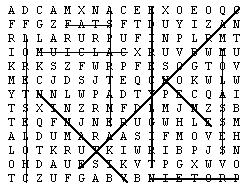
The Ethylene Glycol Tragedy that Triggered the Formation of the FDA
In the 1930's there were no laws in the United States that required drug manufacturers to test drugs before selling them to the public. However, in 1937, 107 people (mostly children) died after taking a liquid formulation of sulfanilamide. "Sulfa" was the first of the "wonder drugs," and a drug company had discovered that it dissolved well in ethylene glycol. Ethylene glycol, ordinarily used for antifreeze, has an appealing sween taste, but it is extremely toxic. The public outrage was so great that Congress passed the 1938 Food, Drug and Cosmetic Act, which required that drugs be cleared for safety before they are put on sale in the marketplace. The young researcher, who discovered that it was ethylene glycol that killed the victims, was the same person, who in the 1960's, stopped thalidomide from being sold in the United States, Dr. Frances Kelsey.
- A chemical code
For "AsO43- C6H12O6" read, "Our son ate glucose."
CHEM 13 NEWS, September 1979, p. 11
- Word search (see Appendix for master copy)

Words about the concepts in this module can be obtained from the clues given. Find these words in the block of letters.
- Polyhydroxy aldehyde or ketone.
- Peptide with more than 100 amino acid residues.
- Lipids that exist as solids at room temperature.
- Iron containing prosthetic group in hemoglobin and the cytochromes.
- Nutrasweet® is the commercial name of this substance.
- Metal ion integral in neurotransmission, intracellular communication, and development of bone structure.
- One example of a steroid compound.
- Ester in which all three hydroxy groups on glycerol have been esterified by saturated or unsaturated fatty acids.
- Member of a group of organic compounds essential in the diet in small amounts.
- Additive that makes white sugar into brown sugar.
Answers: 1. CARBOHYDRATE 2. PROTEIN 3. FATS 4. HEME 5. ASPARTAME 6. CALCIUM 7. CHOLESTEROL 8. TRYGLYCERIDE 9. VITAMIN 10. MOLASSES
- See cartoons at end of module.
- Nutrition by MECC (Minnesota Educational Computer Consortium, St. Paul, MN 55165)--Computer program that takes a day's meals and calculates calories, fat, protein, carbohydrate, vitamins, and minerals. The program also gives suggestions for altering your diet.
- TVO Video (TV Ontario) cassette, Organic Chemistry 2: Industrial Applications has programs on soaps and detergents, cosmetics, glues, and fibers. Other cassettes: From Rags to Britches (artificial fibers); Is It Soup Yet? (cooking); Hair: the Untold Story; and You are What You Eat, TV Ontario Video, 143 West Franklin Street, Suite 206, Chapel Hill, NC 27516; (800) 331-9566
- Software published by Project SERAPHIM, Department of Chemistry, University of Wisconsin-Madison, 1101 University Avenue, Madison, WI 53706-1396: (608) 263-2837 (voice) or (608) 262-0381 (FAX). For the Apple II computer: AP 1522




